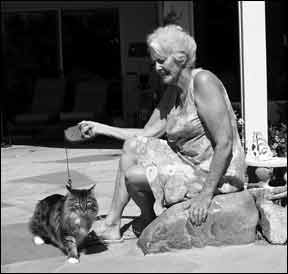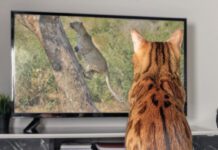Bucky, a striking gray tabby with bright green eyes, touches blades of grass with his nose, rolls around on the sunny deck and sniffs blackberry branches. It’s all part of his regular walk around the fenced backyard with his human companion, who supervises his short outings. Since he is not particularly agile, his owner doesn’t worry about quick escapes or even a leash.

288
Bucky’s feline buddy, however, is a different matter. Jade, an agile black cat, loves the great outdoors as much as Bucky, but her athletic prowess easily has her up, up and away in a matter of seconds. Walking Jade outside requires an appropriate harness and leash.
Whether you live with a Jade or a Bucky type, walking your cat will bear little resemblance to a conventional walk with the dog. Your cat probably will not like striding along at a brisk pace on a concrete sidewalk. That doesn’t mean, however, that taking a walk with your cat isn’t a great idea.
Experts feel that taking your cat outdoors in a safe, supervised manner is excellent enrichment for those cats that enjoy it. Obviously, each cat’s particular situation will determine whether outdoor time is a good option.
Leave Destination Up to Kitty. Not surprisingly, your cat will decide the nature of your walks together. Some cats explore the environment by walking slowly and sniffing. Older kittens will make mad dashes for anything that moves, especially that butterfly. Others prefer to settle themselves outside and quietly watch the world pass by.
To help your cat experience the world, stretch those feline muscles and share time with you, consider the following expert tips:
Choose a quiet area with few dogs and little traffic. If the only place for your cat to be outdoors is a busy, noisy, city street, he may be happier staying inside. (He will definitely be safer.)
Use the right equipment. A variety of sturdy, adjustable harnesses are available for cats, including figure-eight, H-style, and walking-jacket designs. One style of feline walking jacket features an L-shaped section made of sport nylon that curls under the stomach for comfort and support; three nonbinding, adjustable straps buckle on the same side for easy fitting.
Choose a style that fits your cat well and try it out in your home — your cat should be comfortable and secure before you open the door. (A correct fit: Your finger should barely fit between your cat and the harness.) Attach your cat’s harness to a lightweight leash or a lead with a secure clip.
Do not attach a leash to your cat’s collar. Cats easily slip out of collars, especially when pulling against a leash restraint, and using one during a walk will place pressure on a cat’s neck. And avoid retractable leashes — this type of leash requires pulling pressure to move, which cats don’t enjoy, and can leave your cat too far afield — not a good idea in a world where bicyclists, cars and dogs can suddenly appear.
Consider Safety First. Any cat that steps outside should be tested for feline immunodeficiency virus and feline leukemia virus and be up-to-date on recommended vaccinations and heartworm preventative. During walks, be aware of your surroundings and on the alert for things that might startle or frighten your cat. Ensure that your cat is identifiable (ID tag, microchip and/or tattoo) in the unlikely but possible event that you are separated. In addition, never leave your cat unsupervised during even the briefest outings; for instance, cats should not play on balconies or decks alone.
Other Options. No matter how pleasant or enticing you try to make it, however, some cats won’t enjoy walks and should not be forced to go. Remember: What may seem pleasurable to you, or to another animal, may be stressful and scary for your particular pet.
If, despite your best efforts, your cat clearly communicates “NO” to outdoor adventures in the form of hissing, tail thrashing, growling or hiding, other options do exist. For example, try giving your cat scheduled attention, training time and play sessions and rotate her interactive toys.



